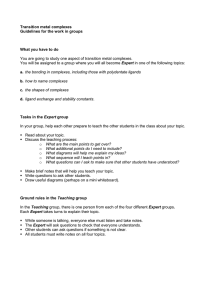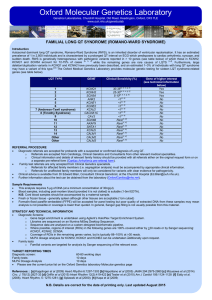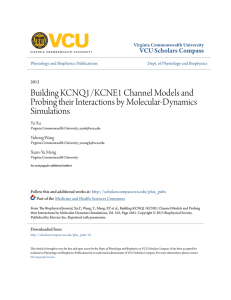Beta Adrenergic Signaling in Heart • Roles of local signaling complexes
advertisement
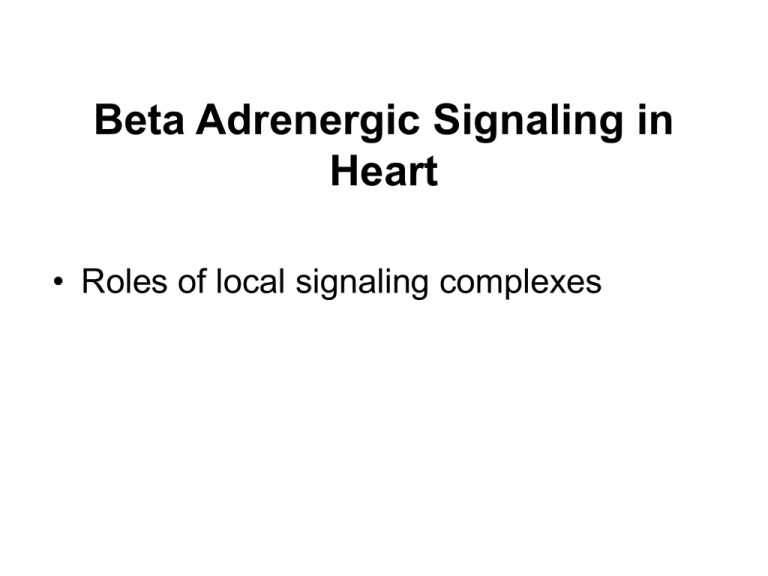
Beta Adrenergic Signaling in Heart • Roles of local signaling complexes The Long QT Syndrome: Dysfunction in Ventricular Repolarization Keating & Sanguinetti, Cell, 2001. Decrease in K Channel Activity or Increase in Na Channel Activity Can Prolong ADP (QT Interval) LQTS: Genetic Linkage to Multiple Ion Channel Genes AP Prolongation Can Trigger Arrhythmias Triggers Are Gene-specific Circ 2001;103:89-95 -Adrenergic Stimulation Shortens AP Duration (Kass & Wiegers, J Physiol. 1982) -AR Regulation of Cardiac AP: A Balance of Inward and Outward Current • L-type Calcium Channel current Increased • Slow IKs potassium channel Current Increased Molecular Architecture of IKS Channel Revealed Through LQTS studies KCNQ1 (KvLQT-1) (minK) KCNE1 (Splawski et al, Circ102;1178-85, 2000) KCNQ1 KCNQ1+KCNE1 50 pA/pF 0.5 s 200 pA/pF Receptor stimulation to Local Signaling Adaptor Proteins: Channel Microsignaling Domains: Macromolecular Complexes Calcium Channel Complex Channels as Macromolecular Signaling Complexes • Signaling Microdomains exapnd diversity of receptor-mediated cellular responses • Disruption of Microdomains in disease can unbalance physiological responses K Channel Complex Functional regulation in TG+ Myocytes but not in CHO cells: Phosphatase and Kinase activity cAMP control Iso 5 8Br-cAMP 10 Increase of tail IKs OA+8Br-cAMP control 8Br-cAMP Tail current (pA/pF) 8 6 4 4 OA 5 3 9 2 5 5 7 2 1 0 -40 -20 0 20 40 Pre-pulse potential (mV) 60 80 0 mouse CHO cell KCNQ1 forms a macromolecular complex Human Heart RyR macromolecular complexes are held together by leucine/isoleucine zippers (LZs) Marx, et al., (2001). The Journal of Cell Biology, 153: 699-708. A leucine zipper motif in KCNQ1 C-terminus : Coordination of protein-protein interactions (LZm = V595A/L602A) The KCNQ1 Macromolecular Complex LZ mutation ablates functional up regulation KCNQ1+ E1+Y control cAMPOA 100 (pA/pF) 100 IKs.tail (pA/pF) LZm KCNQ1+E1+Y 50 50 0 0 -40 -20 0 20 40 (mV) 60 80 -40 -20 0 20 40 (mV) 60 80 Disruption of Macromolecular Complexes in Disease AP Prolongation Can Trigger Arrhythmias State-dependent Block of Ion Channels by drugs • The Modulated Receptor Hypothesis • Hille, B. (1977). Local anesthetics: hydrophilic and hydrophobic pathways for the drug-receptor reaction. Journal of General Physiology 69, 497-515. I II + + + + + + + + + + + + + + III IV + + + + + + + + + + + + + + KPQ Y1795 NH2 COOH Na+ channel open state inactivation Na+ Na+ Closed Open Na+ X Inactivated KPQ 50ms Chandra, R., et. al., (1998) Am. J. Physiol. 274, H1643-H1654. Wild-Type (WT) Y179C (YC) hH1 pA KPQ mV -80 -40 40 -50 -100 80 Binding Sites of LA’s in Na channels: Vladimir Yarov-Yarovoy, Jancy C. McPhee, Diane Idsvoog, Caroline Pate, Todd Scheuer, and William A. Catterall J. Biol. Chem., Vol. 277, Issue 38, 35393-35401, September 20, 2002
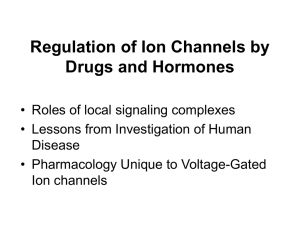
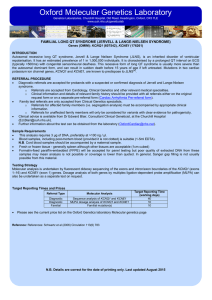
![Anti-KCNQ1 antibody [S37A-10] ab84819 Product datasheet 1 References 3 Images](http://s2.studylib.net/store/data/012700092_1-7612ca95cc2011b36f7ffc8415eee5f4-300x300.png)
